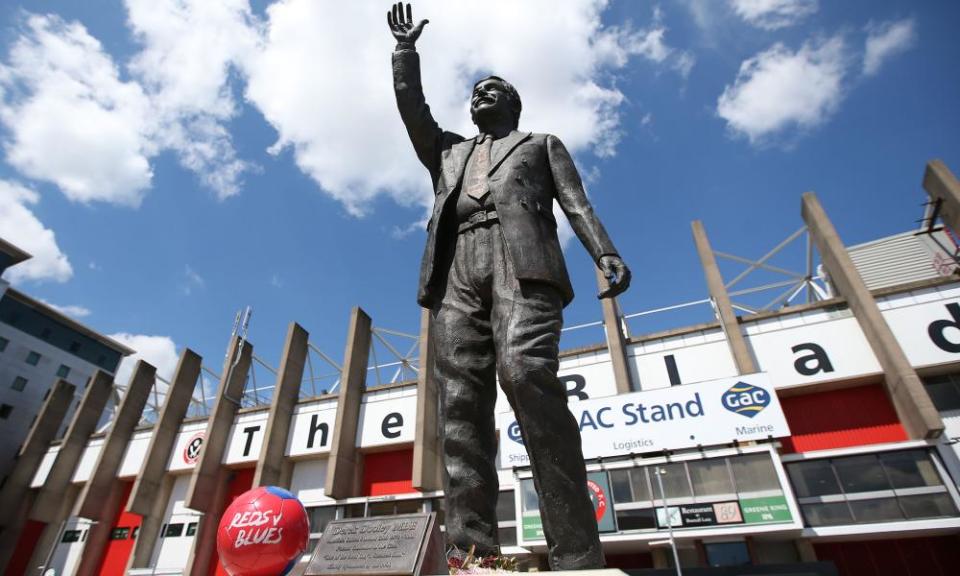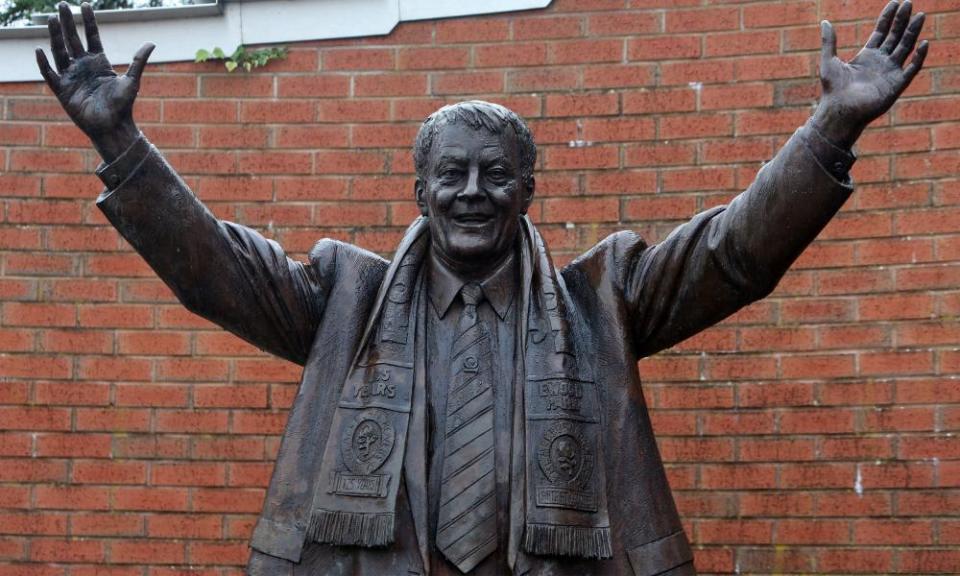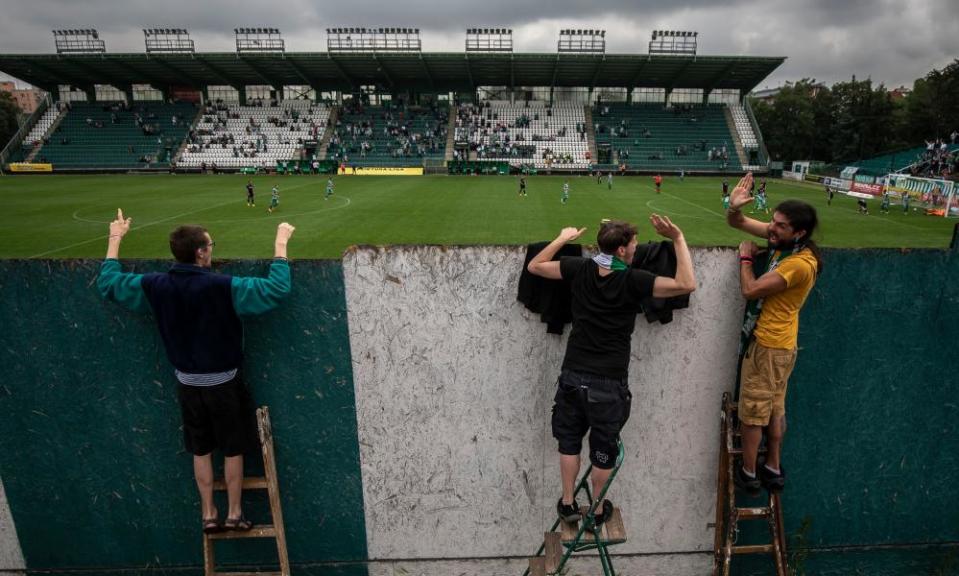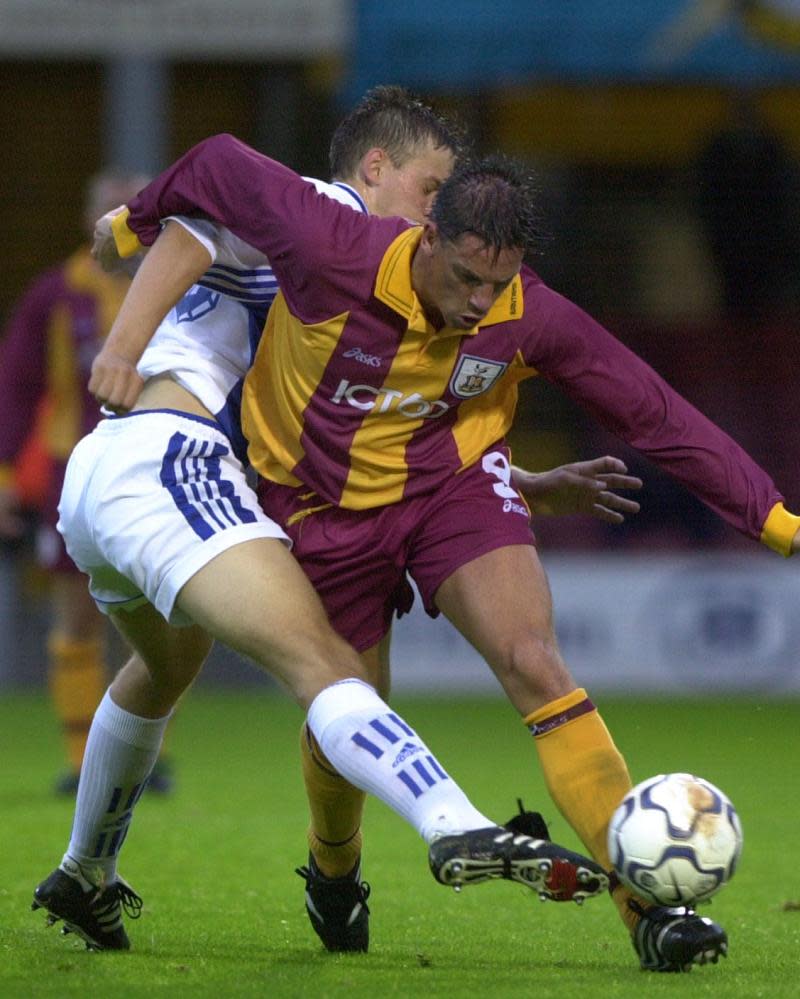Which football clubs have statues of people who did not play for them?

“Has a club ever built a statue in tribute to somebody who has never played for them?” wonders James Preston.
Let’s start by addressing the obvious loophole in this question: the managers. “There is a statue of Bob Stokoe outside the Stadium of Light, in the famous pose of him running on to the pitch at the final whistle of the 1973 FA Cup final,” says Steve Hart. “He never played for Sunderland.”
Other managerial examples include Brian Clough and Peter Taylor (Derby), Sir Bobby Robson (Ipswich and Newcastle), Alf Ramsey (Ipswich), Herbert Chapman (Arsenal), Sir Matt Busby and Sir Alex Ferguson (Old Trafford), Jimmy Hill (Coventry), Bill Shankly (Liverpool), John King (Tranmere) and many others.
Related: Footballers too young to receive their man of the match champagne | The Knowledge
The more interesting examples are those who neither played for or managed the club that later honoured them in statue form. “I’m probably not the first to note that Sheffield United have a statue of former chairman Derek Dooley outside Bramall Lane,” writes Michael Guest. “Not only did Dooley not play for the Blades, but he was actually a prolific goalscorer for rivals Wednesday.
“Dooley had a remarkable story. He scored at a rate of a goal a game for Wednesday, before losing a leg after a fracture became gangrenous. He eventually became the team’s manager, but was cruelly sacked on Christmas Eve, 1973. He went on to join the Blades and had a variety of roles – commercial manager, director and chairman of the board. At a derby match at Hillsborough, he famously received a standing ovation from both sets of fans.”
Dooley’s statue, as Matt Kelcher notes, is dressed in a suit and tie rather than a football kit. So is Jack Walker’s statue at Ewood Park, though he does have a Blackburn Rovers scarf around his neck. Walker was owner of Blackburn from 1991 until his death in 2000, a spell that included their immortal Premier League title win in 1994-95.

If Walker’s statue made perfect sense, the one that Fulham unveiled at Craven Cottage in 2011 was more than a little off the wall. “I might have missed it,” mails Gareth Rogers, “but I’m pretty sure Michael Jackson never turned out for Fulham.”
The Fulham chairman Mohamed Al Fayed, who was great friends with Jackson, commissioned a statue after Jackson’s death in 2009. It was unveiled at Craven Cottage two years later and stayed there for a couple of years until Fayed sold the club to Shahid Khan, who consulted with supporters and got rid of it quick smart. It was housed in the National Football Museum until last year, when it was removed in response to sexual abuse allegations in the documentary Leaving Neverland.
There’s one other statue worth mentioning, even though technically it was commissioned by the local council rather than the club. “There is a statue of a World Cup-winning triumvirate outside the Tameside Stadium, home of Curzon Ashton,” writes Rob Evans. “It features Jimmy Armfield, Geoff Hurst and Simone Perrotta, the Italian midfielder who was born in Ashton-under-Lyme and went on to win the World Cup in 2006. He only found out about the statue a good few years after it was put in place.”
Doppelganger FC
“After a bankruptcy, a Wimbledon-style relocation, and the founding of a fan-owned phoenix club, there will be two CSKA Sofias in the Bulgarian top flight,” writes Daniel Koytchev. “Has anything like this happened before in a nation’s top division?”
There’s nothing new under the sun, Daniel, not even this. “There were two clubs known as Bohemians Praha in the Czech League in 2007-08, and again in 2009-10,” writes Liam McGuigan. “The original club, operating with the suffix ‘1905’ denoting their year of origin, broke away from their parent sports club, which subsequently found another club to fund under the same name. The former FC Strizkov Praha 9 quickly earned promotion to the top flight as Bohemians Praha, but finished bottom on both appearances.”

If you thought that was an unhappy ending, there’s more. “After the courts revoked their right to the name, the club was disbanded,” continues Liam. “Their final season was notable for their refusal to play against their namesakes, for which they were deducted 20 points and finished the season on a glorious -4.”
Alex Turpie has another example from Russia: “Torpedo Zil Moscow were formed by directors of Torpedo Moscow in the 90s and eventually ended up facing their namesake in the top flight in 2001.”
Qualifying for Europe with a negative goal difference (2)
In last week’s Knowledge, we looked at teams who qualified for Europe with a negative goal difference. It was a decent list, including Norwich (1992-93), Everton (2004-05), Parma (2005-06), St Johnstone (2011-12) and Salgueiros, who finished fifth in the Portuguese top flight in 1990-91 with a goal difference of -16. Everyone happy with that? Everyone? Great, let’s all go down the pu …
“Oh come on!” thunders Oliver Raven. “What a pathetic response from fellow readers this week. I did this research last week but assumed somebody else would’ve stumbled across it with a bit of lateral thinking. There are two clubs who qualified for Uefa competitions via the back door with a -30 goal difference.
“Bradford City finished 17th in 2000 and competed in the following season’s Intertoto Cup after nine teams who finished above them refused to cut short their summer break. More recently, in 2015 Go Ahead Eagles also finished 17th (in the 18-team Eredivisie) but entered the first qualifying round of the Europa League the following season via the old Fair Play rule.”

Knowledge archive
“Has a league’s lowest scoring team ever won the title?” wondered Sophie Midwood in 2013.
As far as we could ascertain, it’s happened not once, but twice. The first occasion came in 1998 when AIK won the Swedish title, despite scoring only 25 goals in 26 games. And more recently Aduana Stars romped to the Ghanese championship in 2009-10, despite scoring a faintly ludirous 19 goals in their 30 games – winning the title thanks to their head-to-head record against Ashanti Gold (rather predictably the Stars won one of their meetings 1-0, while the other was a 0-0 draw).
Final standings: P30 W15 D8 L7 F19 A10 Pts53 Pos 1st.
Can you help?
“St Albans City (sixth tier) announced that their sponsor for 2020-21 season will be rock band Enter: Shikari (five UK top 10 albums),” notes Michael France. “That gives a small-big rating of 30. I thought Margate (seventh tier) sponsored by The Libertines might be a good call to beat this but despite their fame they’ve only had two top-10 albums. Giving a score of 14. Can anyone beat St Albans City’s score of 30? No side projects or solo albums allowed to pad the numbers.”
Rudar Velenje went the entire 19/20 Slovenian season without a win yet still earned 12 points from draws. Has a side ever managed a higher points total from a winless season?
— Richard Wilson (@timomouse) August 25, 2020
“Most of the Barcelona team thrashed 8-2 by Bayern Munich also played when Barcelona beat Huesca by the same scoreline in 2018. Has anybody experienced even greater highs and lows – nine or 10-goal victories and defeats – while playing for the same team?” asks Russell Young.
looking at Frank Rijkaard- who went from Sparta Rotterdam to Barcelona, which manager has made the biggest step up in terms of league positions?
— Jon Cullen (@JonCullen8) August 19, 2020
“Excluding abandonments, what examples are there of matches when the referee blew for time too early?” asks Jason Jandu.
• Send your questions and answers to knowledge@theguardian.com or tweet @TheKnowledge_GU.

 Yahoo Sport
Yahoo Sport 





































